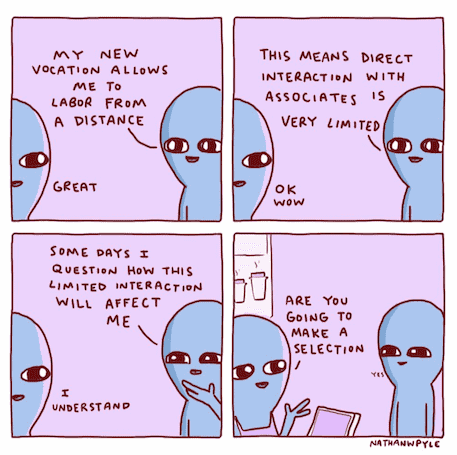Do you feel confident in your remote management skills?
Three years after COVID-19 emerged, the vast majority of organizations around the world have adopted remote work at least partially.
As the pandemic is coming to an end, the prediction of prolific angel investor and founder of AngelList Naval Ravikant seems to be coming true:

In fact, it seems office occupancy in the United States in 2022 is below 50% and it's not looking like that's going to change any time soon:
Biggest permanent change due to the pandemic is remote work:
— Alec Stapp (@AlecStapp) July 11, 2022
Office occupancy still down by more than 50% (!) and the return to office trend is starting to plateau pic.twitter.com/b97OIqVJvL
Even before COVID lockdowns, Remote work had grown by 140% since 2005, nearly 10x faster than the rest of the workforce. Auth0 engineer Artu Klajnerok also built a list of pioneering companies with fully distributed teams by number of employees, which shows it's not just tiny startups anymore:
Biggest distributed companies by employee 🌎@mozilla > 2000@elastic > 1800@InVisionApp > 1300@gitlab > 1000@automattic > 950@digitalocean > 600@auth0 > 560@CloudBees > 500@zapier > 260@CircleCI > 250@Percona > 190@xteam > 180@dribbble > 170@buffer > 140
— Artur Klajnerok (@artur_sfo) November 30, 2019
Who else?
And that's just the tip of the iceberg, as Klajnerok found out after he posted the original list (he's since created a Twitter group with the complete list of distributed companies here):
Added: @CrowdcastHQ, @ExposureNinja, @PSPDFKit, @podia, @ScrapingHub, @StackRaftHQ, @Upwork, @quuu_co, @webflow
— Artur Klajnerok (@artur_sfo) December 3, 2019
In fact, Pre-COVID, over 4.3 million employees (3.2% of the workforce) were already working from home at least half the time according to Global Workplace Analytics.

In 2022, 72% of companies in Buffer’s survey have said they plan to adopt remote work permanently, up from 46% in 2021.

Today, we're here to guide you through the challenges of leading remote teams.
Whether your team needs help dealing with issues common for remote workers or staying motivated, we’ve got you covered.
Table of contents
- The Benefits of Remote Work
- The Challenges of Managing Remote Teams
- Essential Tips for Managing Remote Employees
- Keys for Working from Home During Coronavirus
- Tips for Motivating Remote Teams
- How to Identify Good Remote Employees
- Additional Resources & Further Reading
The Benefits of Remote Work
The rise of remote work might be unavoidable, and you should want to take advantage. Allowing remote work can benefit not only your employees, but you as a manager and the organization as a whole.
According to the Owl Labs State of Remote Work in 2019, more remote workers are putting in forty plus hours per week because they enjoy what they do when compared to on-site workers:

And it's no surprise why, seeing as how they can reap the benefits of zero commutes and the flexibility to craft their own schedule, as reported in Buffer's State of Remote Work 2022:

Not only do remote workers tend to enjoy what they do more and find remote work less stressful in general, but they're more willing to put in extra hours as a result. However, that's just one of the potential benefits of remote work for employees, managers, and companies alike.
The MIT Sloan School of Management's Executive Education Department reported in their Quality of Life Survey that when an employee has a supervisor that's open to flexible (i.e. partially remote) work, that employee is more likely to stay with the company.
MIT's Dr. Peter Hirst of the same department used those findings as inspiration to pilot a flexible work program, with the goal of changing the way his team perceived remote work. He wanted to see what would happen when the team's perception of remote work was changed from a rare privilege to a common opportunity any on the team could take advantage of.
The results speak for themselves:
- 90% reported their family and personal life improved.
- 85% said that their stress was reduced.
- 80% said that their morale and engagement improved.
- 62% felt more trusted and respected.
- And 93% even believed that collaboration was better than before.
Better perceived morale, engagement, trust, retention, and collaboration all came as a result of the opportunity to work remotely, in addition to the personal improvements on the employee side.
Add on top of all of those benefits, according to one study by Stanford professor Nicholas Bloom, remote work offers a tangible boost to productivity even when those employees are only partly remote.
Remote work is about more than just the advancement of technology, it's something that has the potential to help improve the way we work, manage, and lead.
It's not all positive, though. Remote work has its own set of challenges.
The Challenges of Managing Remote Employees
While there are great potential benefits of allowing remote work on your team, there's a problem: most founders and managers still aren't familiar with the challenges of managing remote employees.
Remote work is different from the typical work structure in a few big ways. And while there are big benefits, there are also new and unique challenges with both hiring and managing remote employees that managers never see coming.
You have probably experienced many of these as your time away from the office stretches out.
According to Buffer's State of Remote Work report, these are the major challenges with remote work in general, even outside of a pandemic:

Without any prior experience working remote, it can be hard anticipating the challenges your remote employees will face.
Here's a bit more on some of the major challenges with remote work to help you better understand what your remote workers are going through:
1. Loneliness and isolation
Without a doubt, this is one of the top three challenges all remote workers face:
Isolation for sure. It can get very easy to get in the zone and forget that life exists outside work. But a healthy balance of working from coffee shops and doing outdoor exercise can keep that at bay.
— Eduardo Santos (@edumicro) March 15, 2019
Regular human interaction can be easy to take for granted, until you don't have an office full of people to be around every day.
Socializing and being around others is core to how humans evolved. We're social creatures used to living and working in communities or tribes.
Not surprisingly then, it's a huge health factor that impacts not only our psychology, but even our physical health.
A 2018 Neuroscience report found that when researchers removed mice from their typical highly social structure and put them in isolation away from the group, their brain cells showed signs of social interaction atrophy.
In other words, when they were separated from their social structure, their brain cells started dying off.
Isolation and loneliness in humans are just as detrimental. Prolonged isolation can in extreme cases result in things like anxiety and depression.
As their manager, be aware of this. Do what you can to engage them socially with the rest of the team whenever possible. Also, encourage them to get out of the house, whether going to a coffee shop or co-working space to work, taking a walk with their family, exercising outside, or getting out to go to events or meetups in their area. [Ed. note: We'll have more specifically to helping during COVID in a later section]
2. Communication issues due to a lack of non-verbal cues
Communication is an obvious challenge with managing remote employees, but some of those communication-related challenges aren't so obvious. Yes, you lose some of those hallway conversations, and quick in-office chats, but it goes deeper than that.
When you don't have enough face-to-face communication, it can become difficult to sense intent in messages between you and your team members. It's harder to understand a message when it's only text, or you don't know them as well as other, in-office employees.
The philosophical concept Hanlon's razor, coined by author Robert J. Hanlon, says that we should "assume ignorance before malice,” when communicating with others.
Unfortunately, our minds tend to do the opposite due to thousands upon thousands of years of primal programming that causes us to assume something is a threat by default for the sake of survival. These natural defense mechanisms are sadly unhelpful and counterproductive in the modern workplace.
When you're messaging an employee, and they lack a lot of context, it's easy for them to assume negative intent when you say something they could take as a "threat” (such as when you offer a critique, feedback, ask a question, etc.), and the same goes for you.

Without any of the non-verbal clues that come from what we see and hear, communication issues can easily arise.
Imagine trying to make an important decision with only 7% of the information. Yet, we do that every day with chat and email with your remote team members.
This is why as a team here at Lighthouse, any prolonged conversation on Slack we try to turn into a quick phone call. It's saved us many misunderstandings and quickly helped us move forward aligned and understanding one another.

3. Feeling left out
The feeling of being left out– of company celebrations, consideration for a promotion, and your opinion in general– is more common among remote employees than those on-site.
When you work remotely, you miss out on so many opportunities to connect with your colleagues and managers, from the small– running into each other in the office– to the bigger– Friday happy hours a block from the office.
More than just that, though, you also feel like your teammates don't hear you the same. You can often feel like leadership doesn't take notice of you the way they do those working in office.
A survey of remote employees by job search site Indeed found that 37% of those surveyed believe that working remotely can lead to reduced visibility and less access to company leadership.
[Ed. note: This and other challenges are often less of a problem for fully distributed teams, because everyone, including leadership, understands the challenges of remote work. Also, because everyone is remote, it's easier to develop healthy habits and recognize issues specific to managing remote employees. ]
Another study recently shared in the Harvard Business Review found that remote workers feel more left out:
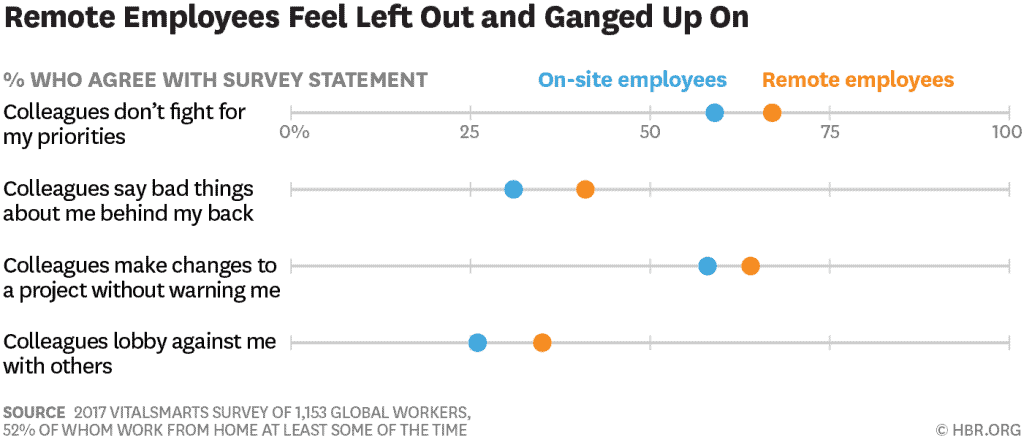
Study authors Joseph Grenny and David Maxfield remarked:
"Unless we take extra measures to build trust and connection with [remote] colleagues, we pay dearly for doing so.
A lack of close contact with people inhibits the formation of trust, connection, and mutual purpose – three ingredients of a healthy social system.”
As with all of these challenges, managers like you have the power to counter this by taking steps like building trust and rapport with your remote workers by making time to get to know them, and having dedicated, regular 1 on 1s with everyone on your team weekly.
Want to learn more about the challenges of remote work in 2022? Check out this episode of the 'Creating High Performing Teams' podcast.
Understanding these challenges will teach you how to manage remote workers
These are just a few of the most common challenges with managing remote teams. Understanding these unique challenges and working through them will improve engagement, productivity, and cohesion across your entire team.
I worked with a largely remote team when I ran product at KISSmetrics, and now, the Lighthouse team today is fully remote.
In the next section, I'll talk about many of the lessons I've learned and advice I've collected along the way that helped me better manage, motivate, and retain remote employees given these unique challenges.
11 Essential Tips for Managing Remote Employees
Remote management can feel like a totally different challenge than managing people you work side by side with. Things that work in an office don't always translate exactly to remote employees.
Use these tips to be more conscious of the unique approaches you should take to managing remote employees.

1) Make time for small talk.
When managing remote employees, it's easy to just talk about what needs to get done and jump off your call, end your chat, and get back to executing. And in some cases, that's exactly what you should do; if you're on a tight deadline, fighting a fire, or just having a quick standup meeting, that makes sense.
However, if that's all you do, you're really missing out on a critical part of management.
You must build rapport with *every* member of your team. Rapport is what will help you work through problems each team member has, trust they can come to you with things important to them, and give you the benefit of the doubt when you make a mistake or an unpopular decision.
Rapport does not come from doing and talking about work. Rapport comes from getting to know them as a complete person.
Ask them what they're into, about their family, and where they're from. Demonstrating that you care is important to them and essential for you to truly understand their motivations. Taking the time to do this will also make them like working for you more.
You can also get more ideas for how to build rapport with your remote team members here.

2) Use video as much as you can.
As we talked about earlier, more than half of human communication is nonverbal. When you don't get to see someone in the office every day, having any type of visual clue to what someone is thinking is essential.
Whether you're gauging their reaction to a change in plans, or just trying to judge their overall mood that day, video tells you way more than an audio-only call, or especially chat will ever reveal.
With so many free and inexpensive solutions for video chat (like Skype, Google Hangouts, and Zoom), there's no reason not to switch to video whenever you can.
If you have connectivity issues, fix it. Don't let it be an excuse for more downstream problems. See if your company can help cover the cost of better internet/more bandwidth for your employee, or encourage them to work somewhere they can more reliably take calls.
Most importantly, trust your instincts when you see something might be wrong. Ask in a call, or make time to ask about it. Those non-verbal clues you see on video are your opportunity to fix problems when they're small for your remote employees.
As you build comfort and trust, and for meetings where you're all looking at a document together anyways, you can always cut back on video there. But when you're trying to build bonds, and especially in your 1 on 1s, video is a valuable tool for you as a manager.

3) Have longer one on ones.
Since you don't have all those moments in the office to build rapport and talk about issues ad hoc, make up for it by setting aside more time for your one on ones with your remote employees. If you don't know were to start, then our 1:1 meeting template will come in handy for you.
Your "open door policy" fails when it's, "call me at a time that works....without our time zones conflicting....when I might be at my desk...but you can't see for sure."
If you ever forget to update your availability on Skype, MS Teams, Slack, etc, realize that your remote employees have no idea when your door is actually "open."
The best way to handle this is to give remote employees a full hour every week on your calendar for one on ones. This ensures you can cover a variety of topics and really dive into issues that aren't covered because they're not in the office for ad hoc discussions.

Listen to the Building Remote Teams Podcast:
I was recently interviewed by Jevin Maltais of the Building Remote Teams podcast, where we talked about the value of one on ones for remote teams and how to make the most of them.
You can listen below for the full episode (Or the full transcript with show notes here):
Come with a variety of remote-specific questions
Because of the unique challenges that remote employees face, it's important to have questions on hand that help dive into those issues they uniquely deal with.
Here are some great remote-specific 1 on 1 questions for you to ask:
- What's your favorite part about working remote? (Understand what drives them)
- What's your daily routine like for working?
- Do you feel included in our team decisions? Why/why not?
- How are the tools we use as a team working out for you remotely? (i.e. Are they handicapped by poor audio on hangouts, or struggle using any tools the team uses?)
- Which of your coworkers do you wish you had more of a connection with? How do you think that would help?
- You visit the office X times a year. Do you feel like that's too much, not enough, or just right?
- How could I better support remote staff like you?
And if this is all new to you, because of working from home due to the Coronavirus quarantines, these questions are key to ask:
- How is your morning routine going now that you don't have to go into work?
- What is your workspace setup so you can focus and get things done during the day? Do you need anything to help?
- What are you planning to do to stay connected with the rest of the team and other colleagues at work? I'd encourage you to schedule some extra calls to make up for the lost ad hoc communication from the office.

4) NEVER cancel a one on one.
One of the fastest ways to build resentment on your team is regularly canceling one on ones.
They'll probably agree if you ask, but that's more about a power dynamic you have as their manager than they really didn't want to talk. There is always more to talk about even when your team members sit next to you.
Remote employees miss out on a lot of things going on in your office. They also miss out on the kinds of information that would naturally spread across an office related to other parts of the company and brief announcements.
One on ones provide an opportunity to make up for that as well as handle all the little things that build up over the course of a week. With so much to cover, you simply cannot afford to miss one for your remote team members.
To keep track of everything you need for your one on ones, download our free meeting template below.

Pick a time that always works for you for your remote 1 on 1s and make them sacred on your calendar. If you absolutely have to, reschedule it, but never cancel.
5) Use animated gifs and emoticons to convey emotion.
Given that so much of communication is non-verbal, it's hard for words alone to convey how you feel about something. Especially in work, words can come across more aggressive, or not as impactful as you may like.
If someone did great work, or there's a good team win, find a gif at a site like giphy.com and send it with the message praising them (you are reinforcing good behavior, right?).
Watch how much better of a reaction you get when you do that instead of just emailing, "Good job." You can get a similar effect if you want to diffuse an email by putting an emoticon at the end to show you're not too serious.

6) Balance schedule inconvenience.
Once you start adding remote employees, it won't be long before you have people across many time zones. That can make meeting scheduling a real challenge. Often, you will get one person that always has calls at awkward times for them.
At KISSmetrics, we had a designer in Australia. When it's 8am there, it's 3pm in SF (our main office) and 6pm on the East Coast (where a lot of the team lived). It always made calls challenging since his day was just beginning when many others were anxious to end their day and eat dinner with their families.
As product manager, I tried to schedule some of my calls with our designer for late at night. 10pm here in San Francisco is a nice 3pm in Australia. It had the desired effect of making calls easier to schedule and I know he appreciated not getting asked to wake up early for another call.
You show a lot of solidarity if every once in a while, team members in your main time zones accommodate your outlier. It will help your team remember the sacrifice their teammate is regularly making and help them empathize more with the distant, remote person.

7) Remember their career paths, too.
It's easy to fall into the trap of thinking of your remote team members as mercenaries helping you get things done. If you hire them as employees, treat them like any other employee, not a freelancer/contractor.
Just like the people in your office, your remote employees have goals and aspirations. Ensuring they make progress on their goals for growth and understand the career paths available by being remote avoids confusion or frustration. (Remember: you can grow people without promotions.)
If you follow through on the recommendation to have an hour for one on ones with your remote employees, you will have plenty of time to talk about their career development during that time.

8) Build a culture of adding people on calls.
It's easy to have discussions and pause and say, "Sam should be involved." If Sam is in the office you will likely grab them and bring them into your meeting, but if Sam is remote, that often gets forgotten or quickly passed over as not worth the hassle.
As a leader, set the example. When situations like that arise, you should go out of your way to get the remote person into the meeting. If you would have interrupted someone in the office, then it's worth bringing them in, or waiting until they're available.
Whether you convey that it doesn't matter or that it is important to loop in your remote team members, the rest of your team will follow your lead.
You can make this easier by having the right tools at your disposal (the same software on everyone's computers, hardware in conference rooms, etc) to reduce the friction of looping someone in.
9) Send swag for your remote workers and their whole family.
Especially if you're a Valley company, you can take swag for granted. However, it's easy to forget about how little swag your remote coworkers have as you sit in a sea of t-shirts by your desk.
In my experience, the moment remote coworkers get their swag is a big deal; getting to work for a company that is exciting, cutting edge, and has cool swag is part of what likely convinced them to join your company instead of something locally.
Send whatever swag you have, so that your remote employees have them, too. They'll feel more connected to the team and not forgotten by the main office that may have people on video wearing swag all the time.
Bonus points to send the right sizes for their husbands, wives, and kids. There's a good chance the family will wear them and next thing you know your swag is on their Facebook and Instagram showing off your awesome company (like my old coworker who lived in Ohio, pictured above).
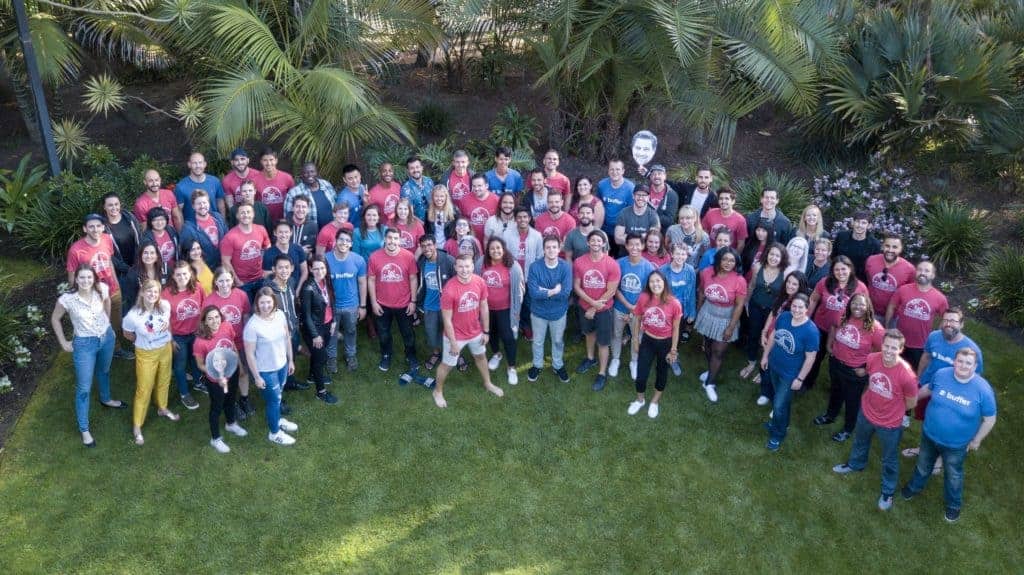
10) Get together face to face at least once a year.
Nothing beats getting everyone together face to face.
You'll always get at least a few, "wow, you look different than you did on video" and other funny reactions. More importantly, though, you'll build more rapport in a few days of teamwork in person than months of remote efforts.
KISSmetrics did a summit once a year when I was there, and many fully-remote companies like Buffer actually travel as a team to exotic places like South Africa.
These gatherings may be pricey at times, but they really pay off long term.
The energy from these gatherings is always high and provides a unique opportunity to have big discussions around culture, vision, and the company or team's future that would be difficult to do with people spread around the world. It also allows for team bonding that you just can't create on a video call.
You also find that many companies will have smaller groups (like a cross functional product team kicking off a big new feature design) meet in a convenient city. This keeps your costs more manageable, while bringing back some of the benefits of being in an office together.

11) Make whiteboarding and ideating remote-friendly.
A final remote best practice is to shift brainstorming of all kinds to being digital.
Think about the spaces, the conversations (often unscheduled– see what Steve Jobs called "Collisions”), and the processes typically involved in ideating within a typical office. Now, imagine how you can create a similar environment online.
Remote employees are at a clear disadvantage when it comes to sharing and bouncing ideas off their team members. However, there are things you can do to make this easier.
Tools for taking brainstorming online
Digital tools for whiteboarding and ideating have a long way to go, but there are several that are effective replacements– or additions– to your brainstorming process.
Head of Remote at AngelList, Andreas Klinger, asked his following on Twitter what tools they prefer for whiteboarding and ideating remotely.
These are the tools most commonly mentioned:
For general brainstorming, Mural:
We've used https://t.co/JHsHZWcgR1 for brainstorming and FunRetro for retrospectives.
— :snowflakelbz: (@dossiette) May 13, 2019
Mural also has templates for retros, but I haven't used them.
For whiteboarding, Miro:
Upwork runs on @MiroHQ (previously called Realtime board) all the way for anything related to whiteboard.
— Utkarsh Sengar (@utsengar) May 13, 2019
For many engineering meetings, we use Google docs + Hangouts.
For retrospectives, Parabol:
We use @parabolco for retros for Techstars Anywhere. It's purpose built to manage retros for remote teams.
— Ryan Kuder 🦄🌊🌮 (@ryankuder) May 13, 2019
Google docs was another common suggestion mentioned for its simplicity, reliability, and familiarity. If you're budget-conscious, the best part then is that your company probably already has access to it if you use Google Apps for email.
And if you want to go lower tech, these can also be worth trying, though your results may vary depending on camera quality:
Whatever you decide to use, keep in mind that extra effort needs to be made on your part as a manager to help improve the quality of your brainstorming sessions.
By investing in improving your partially remote team's whiteboarding, ideating, and other brainstorming processes, you're able to improve the flow of innovation by removing that key challenge of not having your remote team members in the office.

Keys for Working from Home during Coronavirus
Many of you reading today may be scrambling to learn how to be an effective manager remotely. The fact that you're looking for tips is a *great* sign, as your instincts are spot on: managing remotely is very different from managing in person.
With much of the world being asked to work from home as we try to beat COVID-19, suddenly managers and employees alike are scrambling to be productive and work well from their homes.
To help your team do their best in this situation, keep these tips in mind: (and get more tips here)
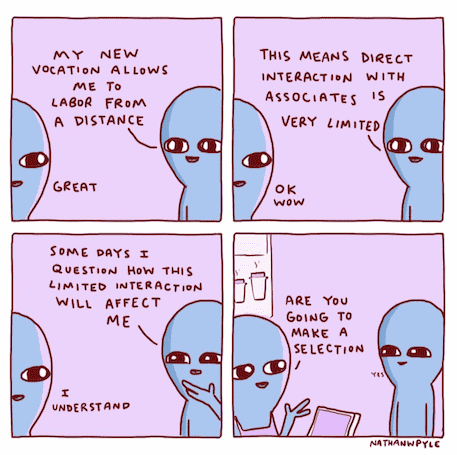
1) Help them fight cabin fever and isolation
Many long time remote workers like to go to coffee shops, have a desk at a co-working space, or another place they can work outside their home. Unfortunately, with COVID, we're all forced to work from home.
Whether you're a bachelor (or bachelorette) living in a tiny studio apartment in a big city, or live in a quiet suburban neighborhood, it can be difficult to spend 24 hours a day in one place.
To combat this, encourage your team members to take a daily walk. There are many cardiovascular benefits to this, and it gets them out of their home without too much risk of infection.
If there's a call they only need to listen into, or you need to talk about something that does not involve screen sharing, encourage them to take a safe walk outside while taking the call (practicing safe distancing of course).
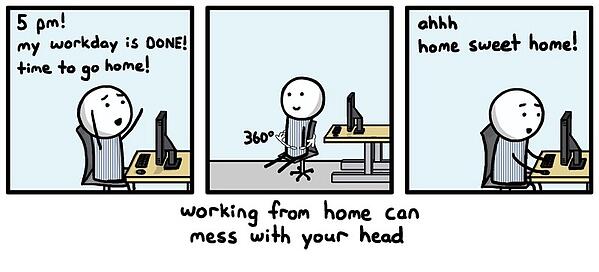
2) Make sure their work space is set up well
If you work from home all the time, you'll set up a great desk, some monitors, and everything else you need. Meanwhile, if you're in a government mandated quarantine, you may have none of that.
Whether you have budget for them to purchase anything, they could take some of their equipment home from the office, or they need to get creative at home, make sure they set up a dedicated place to get work done.
Especially if there are tight quarters like a studio apartment, or they have a spouse, partner, or significant other in quarantine with them, it can be hard to find a working space. This also can be hard if they have kids.
Remote work starts out fun, then instantly turns into the hunger games once you and your spouse have conflicting video calls and only one "professional" space.
— Aaron Levie (@levie) March 6, 2020
This is where your creativity comes into play. A few ideas I've heard that helped:
- A couple with kids takes shifts taking care of them: One person works 9am to 3pm, then the other parent works 3pm to 9pm.
- Bookshelf standing desk: In tight quarters, a bookshelf standing desk is a better alternative to sitting on your bed or couch non-stop.
- Amazon Prime to the rescue: After a few days of discomfort, some people have bought inexpensive office furniture for themselves and thanks to Amazon Prime, it arrived in a couple days.
These are unusual times, so "done beats perfect" when it comes to work spaces. Encourage your team members to try a variety of things and keep what works.

3) Increase your 1 on 1 length & frequency
There is A LOT going on right now that can cause stress, anxiety, and frustration for you and your team. Your 1 on 1s are the best place to help support your team through all of this.
Before this crisis, you and your team did not have to worry about:
- How they'd get work done from home.
- A sudden, double-digit plummet in global GDP.
- Business closures all over the world, and downstream impacts of those changes.
- Concerns about isolation and loneliness on the job.
- Figuring out how to hit your numbers / complete your work with the storm cloud of recession and potential layoffs hanging over everything.
Helping your team be successful in this new normal will pay massive dividends, and your 1 on 1s are likely your only real time to solely focus on them.
Your team needs this kind of pressure relief valve more than ever.
In your 1 on 1s you'll find out how they're really doing, can keep them up to date on changes happening in your company, and answer their questions.
If you're new to 1 on 1s entirely, check out our comprehensive 1 on 1 meetings template, and a step by step guide for starting 1 on 1s here.
Want more advice specifically on working from home during Coronavirus? Learn more in our dedicated post on this transition here "3 Crucial Keys to Helping Your Team Transition to Remote Work Effectively"

Tips for Motivating Remote Employees
Whether you want to motivate or congratulate a team member, if they're on-site all you need to do is walk over to their desk and let them know how awesome they are.
However, for remote workers, it's a little more difficult– and way less effective– to express the same kind of praise or motivational message through a one-line message in chat or email.
While motivating your remote team members is more difficult, there are things you can do– outside of regular one on ones– to let them know what a good job they're doing and motivate them to do their best.
Here are a few tips for motivating your remote employees:

1. Use the power of gifs
As we talked about earlier, chat robs us of important auditory and visual cues that help us draw meaning from communication with another person. That makes chat the worst for effective communication.
Unfortunately, while you might have regular one on ones, your main form of communication for your remote team members is probably chat.
Fortunately, your friend and visual communication tool the gif is here to help; gifs are an amazing and energizing way to communicate virtually any emotion you'd like:

If you communicate primarily over Slack, you can use their Giphy integration to make it easy to drop a quick gif in when you want to praise, congratulate, or spark some other emotion.
The right emoji can turn a simple "good job" into an enthusiastic singing of their praises that makes them smile and feel good the rest of the day.
2. Get creative with group gatherings
It's hard, if not impossible, to replace group gatherings for remote employees. However, if you get creative, there are things you can do to help them feel more included.
Recently a friend shared with me something he did at his last company to make remote employees feel included:
"When the office went out for drinks to celebrate… every other satellite office/remote person was given a celebratory budget and practically forced to go out/stop working at the same time.”
Similarly, you could try a synchronous pizza party or similar celebration where each person joins from their computer at the same time and gives a toast.
Ultimately, it's up to your creativity. Experiment with what you think fits your culture and engage your team for ideas and feedback on what they like and don't like.
There are more ways to connect remotely than ever before and all it really takes is a small effort now and then to show your remote team members that you care.

3. Set up employee development plans
One of the best ways to offer consistent encouragement and motivation for your remote team members is to set up development plans with them during your regular one on ones.
Research by Deloitte found that a key driver of retention for Millennials is mentorship:
"Those intending to stay with their organization for more than five years are twice as likely to have a mentor (68%) than not (32%).”
Keep in mind, you do not need to be the mentor for your own team. Instead, use this as an opportunity for them to get to know some of their peers.
When someone wants to learn about an area of your business or build a new skill, ask yourself who at your company is an expert in that area. Connect them for a call, and while your work is largely done, they'll just be starting a new, healthy relationship with another person at your company.
Meanwhile, beyond mentorship, Millennials want training and development opportunities more than anything else, as Mary Meeker's Internet Trends report found. This growth is even more important to them than flexible hours or cash bonuses:

By having regular one on ones with your remote team members and regularly supporting and checking in on their development plans, you will keep them motivated to move forward with their work and stay at your company long-term.
How to Identify Good Remote Employees
If you've come this far, you are pretty committed to the idea of being great at managing remote employees. The next step is thinking about how to hire great ones.
Chances are, your first remote employee is an existing team member that's asked to transition to partly or full-time remote, whether due to preference or some personal life event. If this hasn't happened yet, it probably will soon.
On the other hand, you may already be making new hires remotely, or you're a founder building your first remote company.
However you become more remote friendly, you may find that your first remote employee leads to a cascade of requests from other members of your team to work partly or even fully remote, too.
So far, we've touched on nearly a dozen tips you can use to better manage your remote employees.
The truth is, though... remote work isn't a good fit for everyone.
Having the discipline to turn off. You never leave the office so you need to find other mechanisms / rituals to institute balance.
— jill gunter (@jillrgunter) March 15, 2019
Remote doesn't work for everyone.
Many people believe they'd be more productive if they had the freedom to work from home. FlexJobs' 6th Annual Work Flex Super Survey found that 76% of employees believe they can get more done remotely due to the frequent distractions in their office.
However, the truth is, some people need the structure of the office to keep focused. According to Avast's 2018 Mobile Workforce Report, 46% of respondents say the greatest downside of working remotely are the distractions, too:
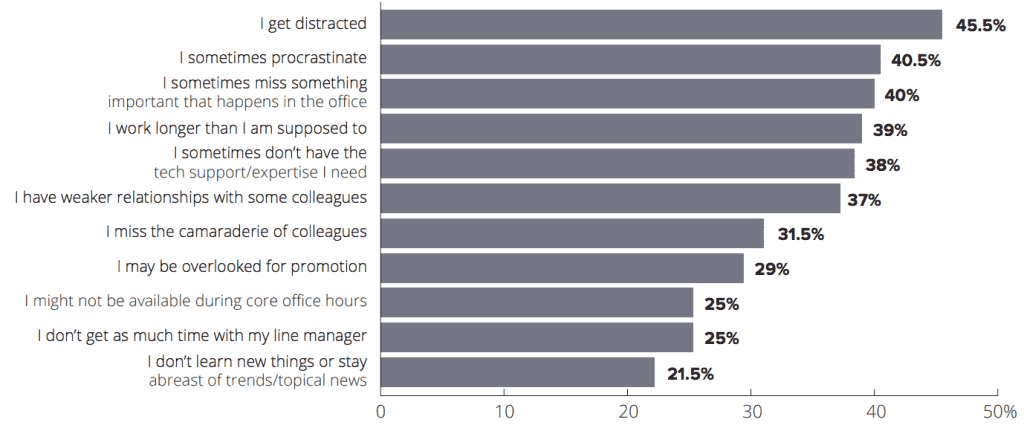
So then, how can you know if someone is a fit for remote work, whether it's a current team member, or new hire?
There are a few things you can do to gauge how fit for remote work someone is, or to establish the kind of culture where remote work is more dependable.
1. Use Task Relevant Maturity to judge their abilities
Working remotely requires a degree of trust that working in an office does not. In an office you:
- Can turn to someone and ask for help instantly.
- Know when someone arrives at work and when they leave.
- See if they look visibly happy, frustrated, tired, sick, or excited.
While you may plan to apply all the lessons we wrote here today to be a successful manager of remote employees, it's still on the employee to do their part.
As you work to build skills in managing remote workers, it's very helpful if the first few people working remote are very skilled in their primary work. This means that their Task Relevant Maturity is high for the tasks you're assigning.
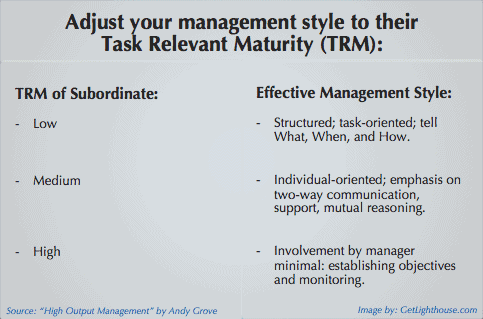
By giving them tasks you already trust them to do well, their transition to working remotely can go much smoother:
- They'll need less hands on coaching and assistance.
- You can check in much less frequently, while still getting quality work.
This gives you and your team member more time to get acclimated to working remotely, without compounding it by them struggling with the tasks they have been asked to do.
Then, as trust builds over time, and you work out any problems with your remote work management habits, you can let them work on lower Task Relevant Maturity tasks; at that point, you'll have established how to best work together, while supporting their unique needs due to working remotely.
Meanwhile, if an employee wants to work remotely and they're taking on a lot of new responsibilities and tasks, it would be wise to ask them to postpone until they start to develop some mastery in those areas first.

2. Look for trust signals with new hires
When hiring a new remote employee, look for signals that suggest they're trustworthy. Small actions can help show whether they're a good fit for remote work:
- Did they show up on time for the interview? (Whether in person, or on time for the call)
- How did they communicate throughout the process? Did you have to followup or were they sending notes, too?
- Did you ask for anything during the interview? Did they send it?
- How are their communication skills?
- Have they worked remotely before? What did they learn?
If they show signs that they're dependable right out of the gate, there's a much higher likelihood that you'll be able to trust them with remote work.
This is why companies like Automattic (listed in Artur Klajnerok's tweet earlier about large, distributed teams) have people do test work before they hire them. From a post on their process:
"Trial projects help both of us determine mutual compatibility and let us evaluate your work, communication, and effectiveness. This work is paid, part-time, and designed to last between two and eight weeks, for a total of around 40 hours of work. This is very flexible, and we'll craft it to work with your schedule."
There's no better way to see if people can handle your company's remote communication style than having them work on a project with you. Best of all, it lets them evaluate your company and their future coworkers, too.
Doing a test project is a great way to make sure someone is a fit, and to build trust even before their first official day. If they're proactive in communication, actively asking questions, and fun to work with on the test, you can trust they'll be that way full time for you as well.
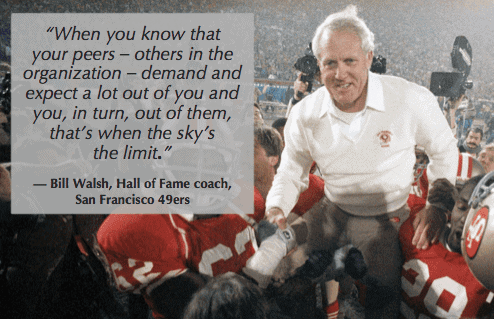
3. Establish a culture of ownership and accountability for managing remote teams
If existing team members are shifting to remote, trial projects and identifying trust signals may not help. Instead, you need to make sure you invest in establishing a culture of ownership and accountability.
When you say you're going to do something, do you come through? Do you trust them to get the job done, assuming they're prepared to handle it on their own? Do you hold them accountable for the results?
The best place to start here is always with you. You're the example that your team will look to emulate. The better you work to live and exemplify this culture of ownership, the more accountable your team members will be as well.
Most importantly, if someone is not particularly reliable in your office, there's very little chance that improves remotely. Instead, as the report from Avast showed, they'll be one of the people struggling working remotely.
When you consider people for remote work, be sure you have full confidence in their accountability, work ethic, and skills. Focus on hiring or granting transitions to remote for people you trust can handle it.
4. Make sure they can handle both asynchronous and synchronous communication
Communication is one of the most important soft skills for every manager and every team member to master, especially in the world of remote work. Choosing the right channel for communicating is essential to how a message will be understood and acted upon.
Your team members can’t be instant messaging you and interrupting your work for every little thing. They also shouldn’t be managing their to-do list in Slack, as notes can easily get lost or forgotten there.
What sets good remote employees apart is knowing when to use asynchronous and synchronous communication methods. To find out if they have an understanding of which one to use in what situations, ask them to share a few examples for each.
They should know that synchronous communication is best used when:
- You need to solve an issue urgently
- You need to find solutions to difficult questions as a group (i.e.- brainstorming)
- You're doing performance reviews or they’re giving/receiving feedback
- You're discussing sensitive topics like someone's problems at work
Meanwhile, asynchronous communication is best used when:
- You need to do complex work that requires at least a few hours of uninterrupted focus
- You’re working on better prepared, researched answers and solutions for a key project
- Your team is working in different time zones and you need a better way to update people instead of a status meeting
- There are a lot of people involved in a project, and so want a more efficient way to update and get input
If they already know most of this and have experience with both synchronous and asynchronous communication tools (Trello, Basecamp, Doist, etc.), that’s a pretty good indicator that they’ll adapt to your team more quickly.
To find out more about this topic, check out: Your Guide to Synchronous vs. Asynchronous Communication, and you can listen to our interview of long-time remote management expert and leader Valentina Thöerner here:

Remote is the future – Are you ready?
There's a lot about managing remote employees that's exactly the same as managing those on-location. However, it's a mistake to assume that a remote employee is the same as one working in the same office as you.
Remote employees are faced with unique challenges and you have to understand those challenges to effectively manage them as part of your team.
Implementing these tips is an investment in not only your team, but in you as a manager. The better you understand the needs and challenges of managing remote employees, the better manager you'll become– and the better prepared you'll be for a world where remote work is quickly becoming the norm.
Ready to enter the world of remote leadership? Want to master managing remote employees? Then check out our additional remote guides and resources to help you master remote management:
Further reading on how to manage remote teams
- If you're getting started with managing remote employees, be sure to check out our master guide: 13 Things You Didn't Plan for When Hiring Remote Employees
- Also, be sure to check out: 5 Things You Didn't Expect When Managing Remote Teams (and what to do about it)
- How to be productive while working remotely: How to Work Remotely Like a Pro: Advice from an Expert
- Building rapport is an essential stepping stone to get your remote teams to trust you and stay motivated. Check out our comprehensive list of ways to build rapport with anyone.
- Avoid these remote management mistakes:
- Additional how-tos specifically for remote workers:
- How to Build Rapport with Your Remote Team Members
- 3 Keys to Helping Your Team Transition to Remote Work Well
- 31 Questions to Ask Remote Employees to Better Support Them
- Remote work: How to lead your team effectively as more work remotely
- How to Do Layoffs (Even If You Have to Do them Remotely)
- Why You Should Start Building Distributed Teams
Are you growing as a leader? Are you building the skills you need?
Whether your team is in office with you or remote, Lighthouse Lessons can teach you the skills you need to better lead, motivate, and grow your team. Let us help you navigate the unique challenges of being a leader like we helped Daniel by learning more and signing up here.

How can I help remote workers?

You can help remote workers by being empathetic to their unique situation. It's a different way to work that can lead to feelings of isolation, loneliness, and struggles communicating.
If you're a coworker, try some of these tips:
1) Use video on calls as much as possible to read body language, and connect more strongly than audio alone would.
2) Use chat tools to have more quick, real time communication.
3) Use emojis and animated gifs to convey emotion to enhance text communication and add personality.
4) Build a culture of adding people to calls just like you'd step out of a conference room to bring in a colleague.
5) Invest in tools to help ideate and whiteboard online by sharing screens, pointing cameras at whiteboards, etc.
And if you're their manager, be sure to do these, too:
1) Have more frequent, longer 1 on 1s to provide coaching, check in on how they're doing, and ensure they're set up well.
2) Help them fight loneliness by encouraging them to take walks, connect with coworkers, and by creating social time.
3) Make sure they have a good workspace setup so they can be comfortable and productive.
4) Create growth plans for them just like you would in person employees.
What are distributed teams?
As opposed to some people within a team working remotely, a fully distributed team is one where all team members work in different locations from one another. They do not have an office together.
The number of companies with fully distributed teams has grown over the past decade, ten times faster than the rest of the U.S. workforce. This includes several hundred companies with dozens to thousands of employees, as was recently documented by Auth0 engineer Artu Klajnerok on Twitter.
How do you manage a distributed team?

Managing a partially distributed team that works mostly on-location has unique challenges to managing a fully distributed team. Here are a few tips to help you whether you're building a fully or partially distributed team:
1) Have frequent 1 on 1s: Check in with them to see how they're doing and give regular coaching.
2) Be aware of the challenges of working remotely: Help them fight loneliness by encouraging them to connect with coworkers, friends, and family, get outside, and be social.
3) Communicate using video as much as possible: This gives you the chance to read their body language and connect more strongly than audio alone.
4) Use chat tools like Slack for faster and more fluid communication. Memes, gifs, and emojis here can help improve everyone's ability to convey emotion and add some humor to the work day.
5) Invest in digital ideation and whiteboard tools to make the process of sharing and bouncing ideas off one another easier remotely.
6) Implement growth plans for remote employees just as you would in person employees.

